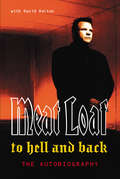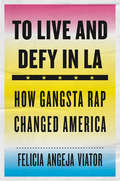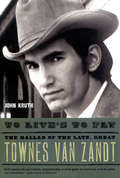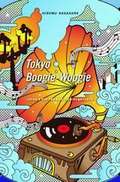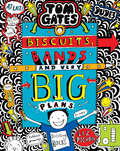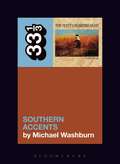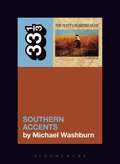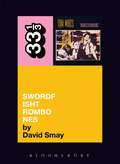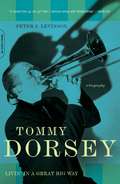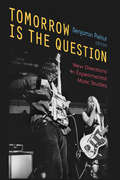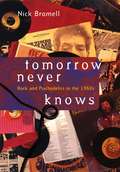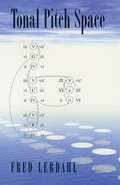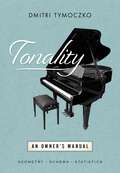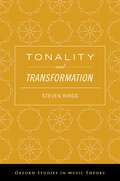- Table View
- List View
To Hell And Back: An Autobiography
by David Dalton Meat LoafMeat Loaf's bizarre and spectacular life story is scarcely credible. After surviving an abusive childhood, during which he was almost murdered by his alcoholic father, he starred in one of the biggest stage and film musicals ever, then went on to record the third best-selling album of all time.To Hell and Back is the true story of a man who ran away from a cruel home life at 17 and starred in the legendary Rocky Horror Picture Show before turning to rock 'n' roll. His first album, Bat Out Of Hell, was considered so uncommercial by his first record label that they dropped him - only for it to go on to sell 20 million copies worldwide. He then spent the 1980s on the skids, with a severe drink and drugs problem and mounting money problems leading him to a nervous breakdown, before making a triumphant comeback with 1993's album Bat Out Of Hell II and colossal hit single 'I'd Do Anything For Love'.This is an extraordinary story and a classic rock autobiography.
To Live and Defy in LA: How Gangsta Rap Changed America
by Felicia Angeja ViatorHow gangsta rap shocked America, made millions, and pulled back the curtain on an urban crisis. How is it that gangsta rap—so dystopian that it struck aspiring Brooklyn rapper and future superstar Jay-Z as “over the top”—was born in Los Angeles, the home of Hollywood, surf, and sun? In the Reagan era, hip-hop was understood to be the music of the inner city and, with rare exception, of New York. Rap was considered the poetry of the street, and it was thought to breed in close quarters, the product of dilapidated tenements, crime-infested housing projects, and graffiti-covered subway cars. To many in the industry, LA was certainly not hard-edged and urban enough to generate authentic hip-hop; a new brand of black rebel music could never come from La-La Land. But it did. In To Live and Defy in LA, Felicia Viator tells the story of the young black men who built gangsta rap and changed LA and the world. She takes readers into South Central, Compton, Long Beach, and Watts two decades after the long hot summer of 1965. This was the world of crack cocaine, street gangs, and Daryl Gates, and it was the environment in which rappers such as Ice Cube, Dr. Dre, and Eazy-E came of age. By the end of the 1980s, these self-styled “ghetto reporters” had fought their way onto the nation’s radio and TV stations and thus into America’s consciousness, mocking law-and-order crusaders, exposing police brutality, outraging both feminists and traditionalists with their often retrograde treatment of sex and gender, and demanding that America confront an urban crisis too often ignored.
To Live's to Fly: The Ballad of the Late, Great Townes Van Zandt
by John KruthAt last, the authorized biography of Townes Van Zandt (1944-1997), who wrote such unforgettable songs as "Pancho & Lefty” and "If I Needed You.” Born to a wealthy oil family in Ft. Worth, Texas, hounded by alcoholism and depression, Van Zandt pursued a nomadic existence following his muse, whatever the cost to himself, friends, and relatives. Based on exclusive interviews with those close to Van Zandt, including his best friend Guy Clark and colleagues like Steve Earle and John Prine, To Live's to Fly captures all the humor, hijinks, poetry, and heartbreak of this revered, genuinely outlaw country artist.
Tokyo Boogie-Woogie: Japan’s Pop Era and Its Discontents
by Hiromu NagaharaEmerging in the 1920s, the Japanese pop scene gained a devoted following, and the soundscape of the next four decades became the audible symbol of changing times. In the first English-language history of this Japanese industry, Hiromu Nagahara connects the rise of mass entertainment with Japan’s transformation into a postwar middle-class society.
Tokyo Boogie-Woogie: Japan’s Pop Era and Its Discontents
by Hiromu NagaharaEmerging in the 1920s, the Japanese pop scene gained a devoted following, and the soundscape of the next four decades became the audible symbol of changing times. In the first English-language history of this Japanese industry, Hiromu Nagahara connects the rise of mass entertainment with Japan’s transformation into a postwar middle-class society.
Tom Gates: Biscuits, Bands And Very Big Plans (Tom Gates Ser. #14)
by Liz PichonBritain's favourite doodle genius and caramel wafer-muncher is back! Yup: Tom Gates and his band The DogZombies have some big plans that need to be actioned, like, NOW! First they need to catch a glimpse into Delia's secret diary. But that'll mean taking a BIG risk: snooping in her room! Oh, and then they're going to write a new smash-hit single. (Which means stocking up on essential snacks.) Plus, Tom's got to doodle as much as possible, _especially_ when the pea-brained Marcus is watching! It's lucky Tom's fuelled by biscuits, or he'd never have the energy for it all...
Tom Petty’s Southern Accents (33 1/3)
by Michael WashburnBy 1985 Tom Petty had already obtained legendary status. He had fame. He had money. But he was restless, hoping to stretch his artistry beyond the confining format of songs like “The Waiting” and “Refugee.” Petty's response to his restlessness was Southern Accents. Initially conceived as a concept album about the American South, Southern Accents's marathon recording sessions were marred by aesthetic and narcotic excess. The result is a hodgepodge of classic rock songs mixed with nearly unlistenable 80s music. Then, while touring for the album, Petty made extensive use of the iconography of the American Confederacy, something he soon came to regret. Despite its artistic failure and public controversy, Southern Accents was a pivot point for Petty. Reeling from the defeat, Petty reimagined himself as deeply, almost mythically, Californian, obtaining his biggest success with Full Moon Fever. Michael Washburn explores the history of Southern Accents and how it sparked Petty's reinvention. Washburn also examines how the record both grew out of and reinforced enduring but flawed assumptions about Southern culture and the Lost Cause of the Confederacy.
Tom Petty’s Southern Accents (33 1/3 #139)
by Michael WashburnBy 1985 Tom Petty had already obtained legendary status. He had fame. He had money. But he was restless, hoping to stretch his artistry beyond the confining format of songs like “The Waiting” and “Refugee.” Petty's response to his restlessness was Southern Accents. Initially conceived as a concept album about the American South, Southern Accents's marathon recording sessions were marred by aesthetic and narcotic excess. The result is a hodgepodge of classic rock songs mixed with nearly unlistenable 80s music. Then, while touring for the album, Petty made extensive use of the iconography of the American Confederacy, something he soon came to regret. Despite its artistic failure and public controversy, Southern Accents was a pivot point for Petty. Reeling from the defeat, Petty reimagined himself as deeply, almost mythically, Californian, obtaining his biggest success with Full Moon Fever. Michael Washburn explores the history of Southern Accents and how it sparked Petty's reinvention. Washburn also examines how the record both grew out of and reinforced enduring but flawed assumptions about Southern culture and the Lost Cause of the Confederacy.
Tom Waits' Swordfishtrombones (33 1/3)
by David SmayTwo entwined narratives run through the creation of Swordfishtrombones and form the backbone of this book. As the 1970s ended, Waits felt increasingly constrained and trapped by his persona and career. Bitter and desperately unhappy, he moved to New York in 1979 to change his life. It wasn't working. But at his low point, he got the phone call that changed everything: Francis Ford Coppola tapped Tom to write the score for One From the Heart. Waits moved back to Los Angeles to work at Zoetrope's Hollywood studio for the next 18 months. He cleaned up, disciplined himself as a songwriter and musician, collaborated closely with Coppola, and met a script analyst named Kathleen Brennan - his "only true love".  They married within 2 months at the Always and Forever Yours Wedding Chapel at 2am. Swordfishtrombones was the first thing Waits recorded after his marriage, and it was at Kathleen's urging that he made a record that conceded exactly nothing to his record label, or the critics, or his fans. There aren't many love stories where the happy ending sounds like a paint can tumbling in an empty cement mixer. Kathleen Brennan was sorely disappointed by Tom's record collection. She forced him out of his comfortable jazzbo pocket to take in foreign film scores, German theatre, and Asian percussion. These two stories of a man creating that elusive American second act, and also finding the perfect collaborator in his wife give this book a natural forward drive.
Tom Waits' Swordfishtrombones (33 1/3)
by David SmayTwo entwined narratives run through the creation of Swordfishtrombones and form the backbone of this book. As the 1970s ended, Waits felt increasingly constrained and trapped by his persona and career. Bitter and desperately unhappy, he moved to New York in 1979 to change his life. It wasn't working. But at his low point, he got the phone call that changed everything: Francis Ford Coppola tapped Tom to write the score for One From the Heart. Waits moved back to Los Angeles to work at Zoetrope's Hollywood studio for the next 18 months. He cleaned up, disciplined himself as a songwriter and musician, collaborated closely with Coppola, and met a script analyst named Kathleen Brennan - his "only true love". They married within 2 months at the Always and Forever Yours Wedding Chapel at 2am. Swordfishtrombones was the first thing Waits recorded after his marriage, and it was at Kathleen's urging that he made a record that conceded exactly nothing to his record label, or the critics, or his fans. There aren't many love stories where the happy ending sounds like a paint can tumbling in an empty cement mixer. Kathleen Brennan was sorely disappointed by Tom's record collection. She forced him out of his comfortable jazzbo pocket to take in foreign film scores, German theatre, and Asian percussion. These two stories of a man creating that elusive American second act, and also finding the perfect collaborator in his wife give this book a natural forward drive.
Tommy Dorsey: Livin' in a Great Big Way, A Biography
by Peter J. LevinsonSwing has never gone out of style. It was the music the Greatest Generation danced to--and went to war to. And no musician evokes the Big Band era more strikingly than Tommy Dorsey, whose soaring trombone play and hit tunes influenced popular music for a generation. Tommy Dorsey (1905-1956) led a rich and complex life. Beginning with his childhood in the coal mining towns of Pennsylvania, we follow the young trombonist's journey to fame and fortune during the Jazz Age. Tommy, with his brother Jimmy, created one of the most popular bands of the era and played with such giants as Bing Crosby and Glenn Miller. They also launched the career of a skinny young singer named Frank Sinatra. But Tommy's volcanic personality eventually split the band and Tommy went off on his own. Drawing on exhaustive new research and scores of interviews with the musicians who knew him best, Levinson delves into Dorsey's famously eccentric lifestyle and his oversize appetite for drink, women, and perfection. The first biography on Dorsey in more than thirty years, Tommy Dorsey is a dazzling portrait of the Big Band's brightest star--his tumultuous life, his turbulent times, and the unforgettable music that made him a legend.
Tommy Dorsey: Livin' in a Great Big Way, A Biography
by Peter J. LevinsonSwing has never gone out of style. It was the music the Greatest Generation danced to--and went to war to. And no musician evokes the Big Band era more strikingly than Tommy Dorsey, whose soaring trombone play and hit tunes influenced popular music for a generation. Tommy Dorsey (1905-1956) led a rich and complex life. Beginning with his childhood in the coal mining towns of Pennsylvania, we follow the young trombonist's journey to fame and fortune during the Jazz Age. Tommy, with his brother Jimmy, created one of the most popular bands of the era and played with such giants as Bing Crosby and Glenn Miller. They also launched the career of a skinny young singer named Frank Sinatra. But Tommy's volcanic personality eventually split the band and Tommy went off on his own. Drawing on exhaustive new research and scores of interviews with the musicians who knew him best, Levinson delves into Dorsey's famously eccentric lifestyle and his oversize appetite for drink, women, and perfection. The first biography on Dorsey in more than thirty years, Tommy Dorsey is a dazzling portrait of the Big Band's brightest star--his tumultuous life, his turbulent times, and the unforgettable music that made him a legend.
Tomorrow Is the Question: New Directions in Experimental Music Studies
by Benjamin PiekutIn recent decades, experimental music has flourished outside of European and American concert halls. The principles of indeterminacy, improvisation, nonmusical sound, and noise, pioneered in concert and on paper by the likes of Henry Cowell, John Cage, and Ornette Coleman, can now be found in all kinds of new places: activist films, rock recordings, and public radio broadcasts, not to mention in avant-garde movements around the world. The contributors to Tomorrow Is the Question explore these previously unexamined corners of experimental music history, considering topics such as Sonic Youth, Julius Eastman, the Downtown New York pop avant-garde of the 1970s, Fluxus composer Benjamin Patterson, Tokyo’s Music group (aka Group Ongaku), the Balinese avant-garde, the Leicester school of British experimentalists, Cuba’s Grupo de Experimentación Sonora del ICAIC, Pauline Oliveros’s score for the feminist documentary Maquilapolis, NPR’s 1980s RadioVisions, and the philosophy of experimental musical aesthetics. Taken together, this menagerie of people, places, and things makes up an actually existing experimentalism that is always partial, compromised, and invented in its local and particular formations—in other words, these individual cases suggest that experimentalism has been a far more variegated set of practices and discourses than previously recognized. Asking new questions leads to researching new materials, new individuals, and new contexts and, eventually, to the new critical paradigms that are necessary to interpret these materials. Gathering contributions from historical musicology, enthnomusicology, history, philosophy, and cultural studies, Tomorrow Is the Question generates future research directions in experimental music studies by way of a productive inquiry that sustains and elaborates critical conversations.
Tomorrow Never Knows: Rock and Psychedelics in the 1960s
by Nick BromellTomorrow Never Knows takes us back to the primal scene of the 1960s and asks: what happened when young people got high and listened to rock as if it really mattered—as if it offered meaning and sustenance, not just escape and entertainment? What did young people hear in the music of Dylan, Hendrix, or the Beatles? Bromell's pursuit of these questions radically revises our understanding of rock, psychedelics, and their relation to the politics of the 60s, exploring the period's controversial legacy, and the reasons why being "experienced" has been an essential part of American youth culture to the present day.
Tonal Pitch Space
by Fred LerdahlBuilding on the foundation of Lerdahl and Jackendoff's influential A Generative Theory of Tonal Music, this volume presents a multidimensional model of diatonic and chromatic spaces that quantifies listeners' intuitions of the relative distances of pitches, chords, and keys from a given tonic. The model is employed to assign prolongational structure, represent paths through the space, and compute patterns of tension and attraction as musical events unfold, thereby providing a partial basis for understanding musical narration, expectation, and expression. Conceived as both a music-theoretic treatise and a contribution to the cognitive science of music, this book will be of interest to music theorists, musicologists, composers, computer musicians, and cognitive psychologists.
Tonal Pitch Space
by Fred LerdahlBuilding on the foundation of Lerdahl and Jackendoff's influential A Generative Theory of Tonal Music, this volume presents a multidimensional model of diatonic and chromatic spaces that quantifies listeners' intuitions of the relative distances of pitches, chords, and keys from a given tonic. The model is employed to assign prolongational structure, represent paths through the space, and compute patterns of tension and attraction as musical events unfold, thereby providing a partial basis for understanding musical narration, expectation, and expression. Conceived as both a music-theoretic treatise and a contribution to the cognitive science of music, this book will be of interest to music theorists, musicologists, composers, computer musicians, and cognitive psychologists.
Tonal Structures in Early Music (Criticism and Analysis of Early Music #Vol. 1)
by Cristle Collins JuddFirst Published in 2000. Routledge is an imprint of Taylor & Francis, an informa company.
Tonal Structures in Early Music (Criticism and Analysis of Early Music)
by Cristle Collins JuddFirst Published in 2000. Routledge is an imprint of Taylor & Francis, an informa company.
Tonality: An Owner's Manual (OXFORD STUDIES IN MUSIC THEORY)
by Dmitri TymoczkoThis encyclopaedic book proposes a sweeping reformulation of the basic concepts of Western music theory, revealing simple structures underlying a wide range of practices from the Renaissance to contemporary pop. Its core innovation is a collection of simple geometrical models describing the implicit knowledge governing a broad range of music-making, much as the theory of grammar describes principles that tacitly guide our speaking and writing. Each of its central chapters re-examines a basic music-theoretical concept such as voice leading, repetition, nonharmonic tones, the origins of tonal harmony, the grammar of tonal harmony, modulation, and melody. These are flanked by two largely analytical chapters on rock harmony and Beethoven. Wide-ranging in scope, and with almost 700 musical examples from the Middle Ages to the present day, Tonality: An Owner's Manual weaves philosophy, mathematics, statistics, and computational analysis into a new and truly twenty-first century theory of music.
Tonality: An Owner's Manual (OXFORD STUDIES IN MUSIC THEORY)
by Dmitri TymoczkoThis encyclopaedic book proposes a sweeping reformulation of the basic concepts of Western music theory, revealing simple structures underlying a wide range of practices from the Renaissance to contemporary pop. Its core innovation is a collection of simple geometrical models describing the implicit knowledge governing a broad range of music-making, much as the theory of grammar describes principles that tacitly guide our speaking and writing. Each of its central chapters re-examines a basic music-theoretical concept such as voice leading, repetition, nonharmonic tones, the origins of tonal harmony, the grammar of tonal harmony, modulation, and melody. These are flanked by two largely analytical chapters on rock harmony and Beethoven. Wide-ranging in scope, and with almost 700 musical examples from the Middle Ages to the present day, Tonality: An Owner's Manual weaves philosophy, mathematics, statistics, and computational analysis into a new and truly twenty-first century theory of music.
Tonality and Transformation (Oxford Studies in Music Theory)
by Steven RingsTonality and Transformation is a groundbreaking study in the analysis of tonal music. Focusing on the listener's experience, author Steven Rings employs transformational music theory to illuminate diverse aspects of tonal hearing - from the infusion of sounding pitches with familiar tonal qualities to sensations of directedness and attraction. In the process, Rings introduces a host of new analytical techniques for the study of the tonal repertory, demonstrating their application in vivid interpretive set pieces on music from Bach to Mahler. The analyses place the book's novel techniques in dialogue with existing tonal methodologies, such as Schenkerian theory, avoiding partisan debate in favor of a methodologically careful, pluralistic approach. Rings also engages neo-Riemannian theory-a popular branch of transformational thought focused on chromatic harmony-reanimating its basic operations with tonal dynamism and bringing them into closer rapprochement with traditional tonal concepts. Written in a direct and engaging style, with lively prose and plain-English descriptions of all technical ideas, Tonality and Transformation balances theoretical substance with accessibility: it will appeal to both specialists and non-specialists. It is a particularly attractive volume for those new to transformational theory: in addition to its original theoretical content, the book offers an excellent introduction to transformational thought, including a chapter that outlines the theory's conceptual foundations and formal apparatus, as well as a glossary of common technical terms. A contribution to our understanding of tonal phenomenology and a landmark in the analytical application of transformational techniques, Tonality and Transformation is an indispensible work of music theory.
Tonality and Transformation (Oxford Studies in Music Theory)
by Steven RingsTonality and Transformation is a groundbreaking study in the analysis of tonal music. Focusing on the listener's experience, author Steven Rings employs transformational music theory to illuminate diverse aspects of tonal hearing - from the infusion of sounding pitches with familiar tonal qualities to sensations of directedness and attraction. In the process, Rings introduces a host of new analytical techniques for the study of the tonal repertory, demonstrating their application in vivid interpretive set pieces on music from Bach to Mahler. The analyses place the book's novel techniques in dialogue with existing tonal methodologies, such as Schenkerian theory, avoiding partisan debate in favor of a methodologically careful, pluralistic approach. Rings also engages neo-Riemannian theory-a popular branch of transformational thought focused on chromatic harmony-reanimating its basic operations with tonal dynamism and bringing them into closer rapprochement with traditional tonal concepts. Written in a direct and engaging style, with lively prose and plain-English descriptions of all technical ideas, Tonality and Transformation balances theoretical substance with accessibility: it will appeal to both specialists and non-specialists. It is a particularly attractive volume for those new to transformational theory: in addition to its original theoretical content, the book offers an excellent introduction to transformational thought, including a chapter that outlines the theory's conceptual foundations and formal apparatus, as well as a glossary of common technical terms. A contribution to our understanding of tonal phenomenology and a landmark in the analytical application of transformational techniques, Tonality and Transformation is an indispensible work of music theory.
Tone Psychology: The Sensation of Successive Single Tones (Classic European Studies in the Science of Music)
by Carl StumpfCarl Stumpf (1848-1936) was a German philosopher and psychologist and a visionary and important academic. During his lifetime, he ranked among the most prominent scientists of his time. Stumpf's intention, as evident in his book, Tone Psychology, was to investigate the phenomenon of tone sensation in order to understand the general psychic functions and processes underlying the perception of sound and music. It could be argued that modern music psychology has lost or perhaps ignored the epistemological basis that Carl Stumpf developed in his Tone Psychology. To gain a confident psychological basis, the relevance of Stumpf's deliberations on music psychology cannot be overestimated. Analyses of the essence of tones, complex tones and sounds are fundamental topics for general psychology and epistemology. By the end of this two-volume work, Stumpf had established an epistemology of hearing. The subject of Volume I is the sensation of successive single tones. Stumpf demonstrates that analysis leads to the realisation of a plurality (is there only one tone or are there several tones?), which is then followed by a comparison: an increase may be observed (one tone is higher than the other) or a similarity may be realised (both tones have the same pitch or the same loudness). With almost mathematical stringency, Stumpf developed a topology of tones. Volume II deals with the sensation of two simultaneous tones (musical intervals). The books are stimulating, rewarding and provocative and will appeal to music psychologists, music theorists, general psychologists, philosophers, epistemologists and neuroscientists.
Tone Psychology: The Sensation of Successive Single Tones (Classic European Studies in the Science of Music)
by Carl StumpfCarl Stumpf (1848-1936) was a German philosopher and psychologist and a visionary and important academic. During his lifetime, he ranked among the most prominent scientists of his time. Stumpf's intention, as evident in his book, Tone Psychology, was to investigate the phenomenon of tone sensation in order to understand the general psychic functions and processes underlying the perception of sound and music. It could be argued that modern music psychology has lost or perhaps ignored the epistemological basis that Carl Stumpf developed in his Tone Psychology. To gain a confident psychological basis, the relevance of Stumpf's deliberations on music psychology cannot be overestimated. Analyses of the essence of tones, complex tones and sounds are fundamental topics for general psychology and epistemology. By the end of this two-volume work, Stumpf had established an epistemology of hearing. The subject of Volume I is the sensation of successive single tones. Stumpf demonstrates that analysis leads to the realisation of a plurality (is there only one tone or are there several tones?), which is then followed by a comparison: an increase may be observed (one tone is higher than the other) or a similarity may be realised (both tones have the same pitch or the same loudness). With almost mathematical stringency, Stumpf developed a topology of tones. Volume II deals with the sensation of two simultaneous tones (musical intervals). The books are stimulating, rewarding and provocative and will appeal to music psychologists, music theorists, general psychologists, philosophers, epistemologists and neuroscientists.
Tonic to the Nation: Making English Music in the Festival of Britain
by Nathaniel G. LewLong remembered chiefly for its modernist exhibitions on the South Bank in London, the 1951 Festival of Britain also showcased British artistic creativity in all its forms. In Tonic to the Nation, Nathaniel G. Lew tells the story of the English classical music and opera composed and revived for the Festival, and explores how these long-overlooked components of the Festival helped define English music in the post-war period. Drawing on a wealth of archival material, Lew looks closely at the work of the newly chartered Arts Council of Great Britain, for whom the Festival of Britain provided the first chance to assert its authority over British culture. The Arts Council devised many musical programs for the Festival, including commissions of new concert works, a vast London Season of almost 200 concerts highlighting seven centuries of English musical creativity, and several schemes to commission and perform new operas. These projects were not merely directed at bringing audiences to hear new and old national music, but to share broader goals of framing the national repertory, negotiating between the conflicting demands of conservative and progressive tastes, and using music to forge new national definitions in a changed post-war world.
